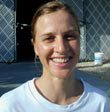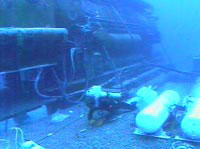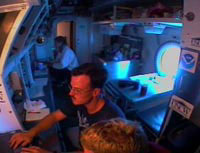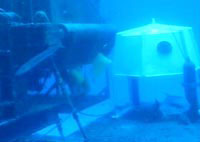Hannah Stewart is the controlled flow environment specialist on the mission at Aquarius, where a team of six aquanauts will spend nine days in the underwater laboratory 63 feet below the ocean’s surface in Florida Keys National Marine Sanctuary.

Tuesday, 13 Jun 2000
CONCH REEF, Fla
CONCH REEF, Fla. Woke up this morning after feeling like we’d been rocked all night by waves. We weren’t moving but the waves passing overhead pulled on our ears and we felt their cycles. It’s chilly in the bunks at night — the walls of Aquarius are cool and a touch against a wall delivers a cold wake-up. We did, however, sleep soundly under the waves, exhausted from our day of diving yesterday and the pressure of the underwater laboratory.
Breakfast of grits and cheese and coffee as we went over the day’s dive plan. Pulling on our wet dive gear is a lot of work. We all wear several layers: lycra dive skin and lycra socks, two layers of neoprene wetsuits, booties, hoods, and sometimes gloves. It’s a lot to wear, but the multiple layers keep us relatively warm (or at least keep us from freezing — the water is 82 degrees) on our 3.5 hour dives. Our gear doesn’t dry overnight and is soggy each time we put it on.
It’s a relief to get down into the water of the wet porch, where our gear feels more natural as it fills with water and loosens as we move around. The double tanks that we wear are heavy to put on in the wet porch. We are equipped with two reels of excursion line, a radio in Plexiglas housing, a pouch containing a map of the reef around Aquarius, a strobe light, a back-up light, a sausage buoy, and a slate. In all, we’re wearing almost 100 pounds of equipment when we’re fully geared up. It’s bulky in air, but in the water we’re free! It becomes weightless as we leave the wet porch and enter the ocean.
This morning we split into two buddy teams. Jim and Mike headed out at 7:00 a.m. to the deep S-4 site for nutrient sampling, and Greg and I followed at 7:30. On the commute out to the reef, three large Eagle rays flew by in single file and we saw a turtle leisurely patting the coral heads with its flippers as it swam along, seemingly without effort. Greg and I arrived at the S-4 site and collected the sampling gear from Jim and Mike, took a sample at 8:00 a.m., when we felt the water temperature drop and become chilly, and another at 8:15 a.m., as scheduled.
The morning dive continued with buddy teams exchanging the nutrient sampling equipment as we alternated between sampling and swimming back to the Habitat to fill our tanks. Our surface support team (Cyd and Emina) dove down to collect our samples at 11:00 a.m., and also delivered a bag of carrots and celery for us. (It’s difficult to keep fruit and vegetables from going bad down here. The cooler only stays so cool — so the fresh veggies were a real treat!)
We staggered into Aquarius around noon — eager for hot lunch and a nap. After such a long dive we require a four-hour “Habitat interval” before going out for another dive and the time seems just enough to eat and collapse on our bunks.
The afternoon dive plan had Mike and Jim out collecting nutrient samples at the deep S-4 site and Greg and I setting up the ADV (Acoustic Doppler Velocimeter) for a test run. We’ll use this velocimeter to characterize water flow speeds at various positions on the reef during and between internal tide events. A long cable attaches the ADV probe to a computer inside Aquarius. The probe is positioned on the reef and communication between the divers with the probe and the person working the program on the computer occurs through an AGA — a full-face mask with a microphone and earphones for the diver and a headset for the dry person running the computer. The equipment worked and the probe is set up out on the reef, where we will collect flow data tomorrow.
A big southern stingray was half-buried in the sand next to Aquarius as we headed out this afternoon. It let us get very close before slowly rippling its wings and swimming away. We saw a smaller one on our way back in from our afternoon dive. It’s amazing to be in the water for such long periods of time — usually it seems that research dives are so focused and rushed that you see only what you are working on. Here, with hours in the water and long swims along the reef, I get a sense of what it is like down here all the time. Even at our dining table and in our bunks, we peer out large portholes at the thousands of fish that live around the laboratory. They peer back.
We were all back in the Habitat by 7:30 p.m., where we took hot showers and layered on shirts, sweatshirts, sweatpants, and socks to stay warm. Dinner of freeze-dried camping food, which is actually pretty good. It’s all I can do to stay awake for dinner and play a few rounds of dominoes with my fellow aquanauts, go over tomorrow’s plan (which entails an early wake-up for Jim and Mike for their first dive at 6 a.m. — Greg and I dive at 8 a.m.), write a journal, and, now, fall into my bunk.




